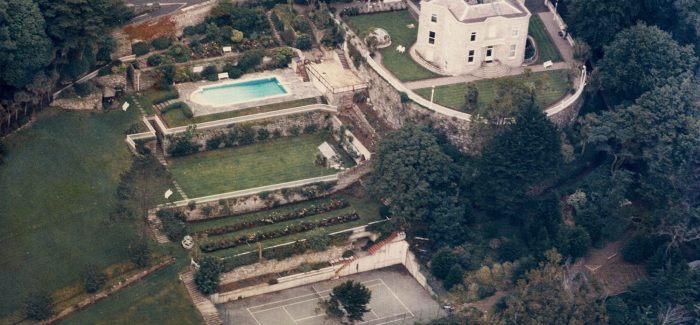Mount Eagle
| Name | Mount Eagle |
|---|---|
| Previous Names | Coburg Lodge |
| Address | Vico Road |
| Year Built | 1838 |
| Architect | Sandham Symes |
| Exists today | Yes |
| On 1888 map | Yes |
Thesis by Orla McShane 1988
Thanks to Orla McShane for contributing the piece below which is an extract from her Thesis on ‘The Life and Works of Sandham Symes Jr.’ Submitted to Trinity College, Dublin in April 1988.
In this chapter I will discuss Symes’s work on the Killiney estate of his grandfather, Robert Warren. Between 1838 and 1859 he did major alterations to the Warren house, Loftus Hill (now Killiney Castle) and designed two houses, a church and several lodges, all executed in the local granite. They form a collection of unique buildings which give an important picture of Symes’s early work, at its best. In 1848 Symes exhibited a model of this estate and its houses at the Royal Dublin society. This no longer exists but we do have a map of the estate in 1857 which is a useful guide to Symes’s Killiney work.
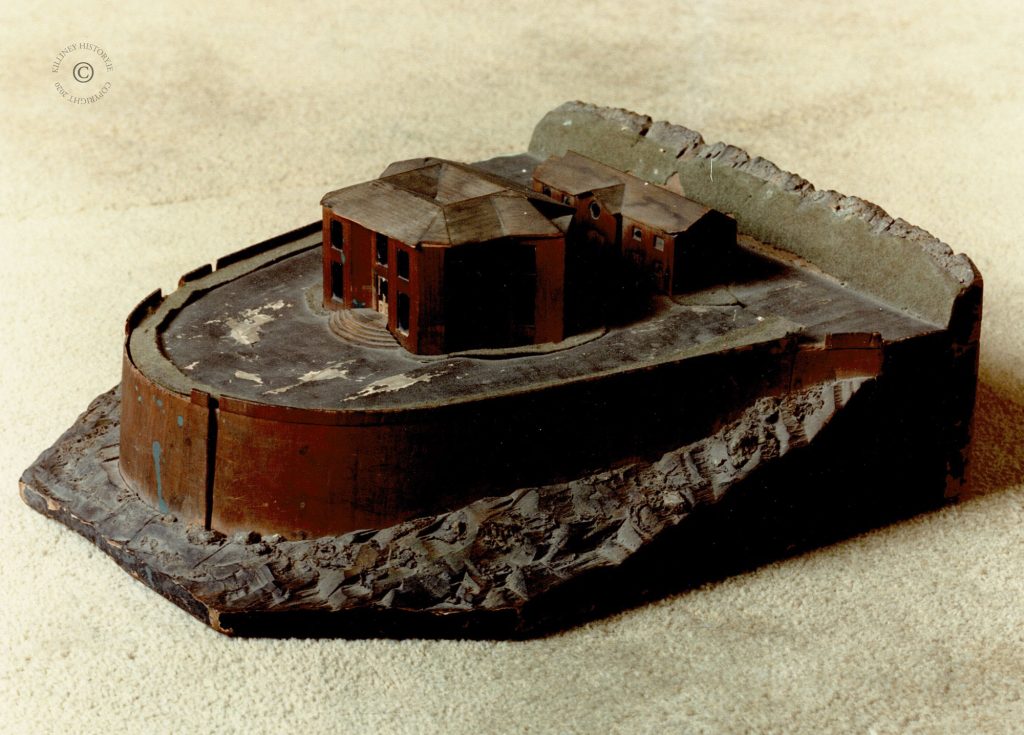
In 1838 Symes exhibited plans of ‘a villa, now erecting at Brighton Cliff, at the south side of Killiney Hill, for Robert Warren Esq.’ at the Royal Hibernian Academy. These plans were for Mount Eagle, one of Symes’s earliest works on the estate. In 1843 he exhibited a model of Mount Eagle, also at the Royal Hibernian Academy. The following year, he exhibited the model at the exhibition of manufactures at the Royal Dublin Society and was awarded a silver medal. This wooden model and another, executed in stone, still survive at Mount Eagle.
This solid, granite villa is dramatically situated on a steep cliff facing out to sea. Steps lead up to the front door which is placed between two half-octagons. It leads through a rectangular hall to a staircase which divides at the half-landing. Two doorways in the hall lead to the dining room and the drawing room. So far, the plan is quite normal, but ‘freakish geometry’ is displayed in the positioning of the rooms on either side of the staircase. They ‘diverge at 45 degrees, and the outline of the house has, in consequence, triangular salients at the two landward corners. Roofs and stacks follow the 45-degree axes.’ This can clearly be seen in the ground-plan.
There is a strong horizontal emphasis in the facade. In his later houses Symes will create an even stronger horizontal effect with the use of boldly projecting eaves. Here, the effect is created by the combination of two string courses, which divide the storeys, and the bold cornice which caps the house. This emphasis and the unusual geometry show that Charlemont Fort, Co. Tyrone was Symes’s model for Mount Eagle.
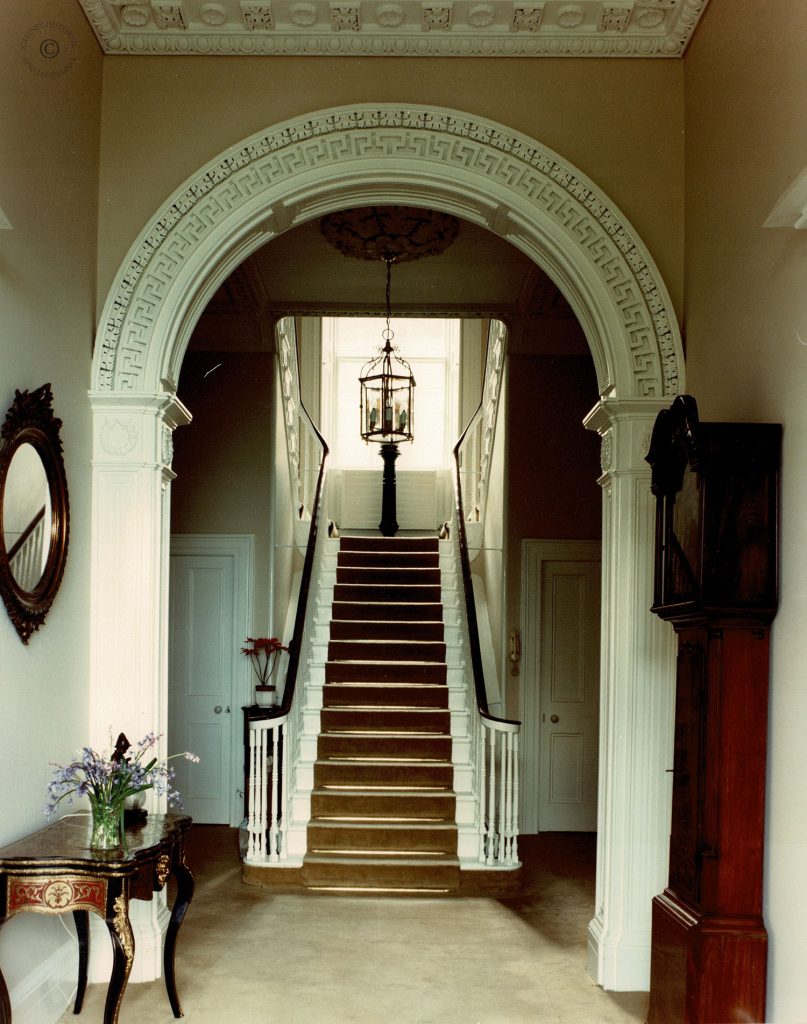
The interior of Mount Eagle has some rich decorative features. The first thing that catches the eye is the plaster work which has a combination of foliage and greek patterns modelled in high relief. Many motifs in this plaster work are repeated in the woodwork, eg. the double greek key pattern. Another motif which Symes favoured was the scroll, which can be seen on the staircase at Mount Eagle. Scrolls can also be seen in the brackets supporting a stylized cornice and pediment over the front door. Symmetry was an important element of this interior, and on the landing there is a false door.
Also worthy of note at Mount Eagle is the coach-house with it’s granite window and door surrounds. Originally it had two storeys but a third was added on early in this century. The gate-piers are also intersting and we will see a similar pair at Altadore. Victoria Castle, now Ayesha Castle was built by Robert Warren at the same time as Mount Eagle, circa 1840. Both houses were built speculatively. It is not clear who designed the castle, but there are two possible candidates, Hoskins and Sandham Symes.
In June 1841, The Irish Penny Journal reported that plans for a new town, proposed to be built on Killiney Hill, had been drawn up, and ‘laid before the public, with a view to obtaining the necessary ways and means to give it a more substantial reality’. The new town was to be called Queenstown. These plans were drawn up by Hoskins and Son, and they still survive today. The first is a view of the town from Killiney Bay and the second shows how the hill was to be divided into plots. These plans came to nothing, but The Irish Penny Journal reported that ‘the first stone of the new town has been laid; nay the first building – no less a building than ‘Victoria Castle’ – has been actually erected’. For this reason, and because Victoria Castle is not built in a style more typical of Symes, it has often been thought that Hoskins designed it.
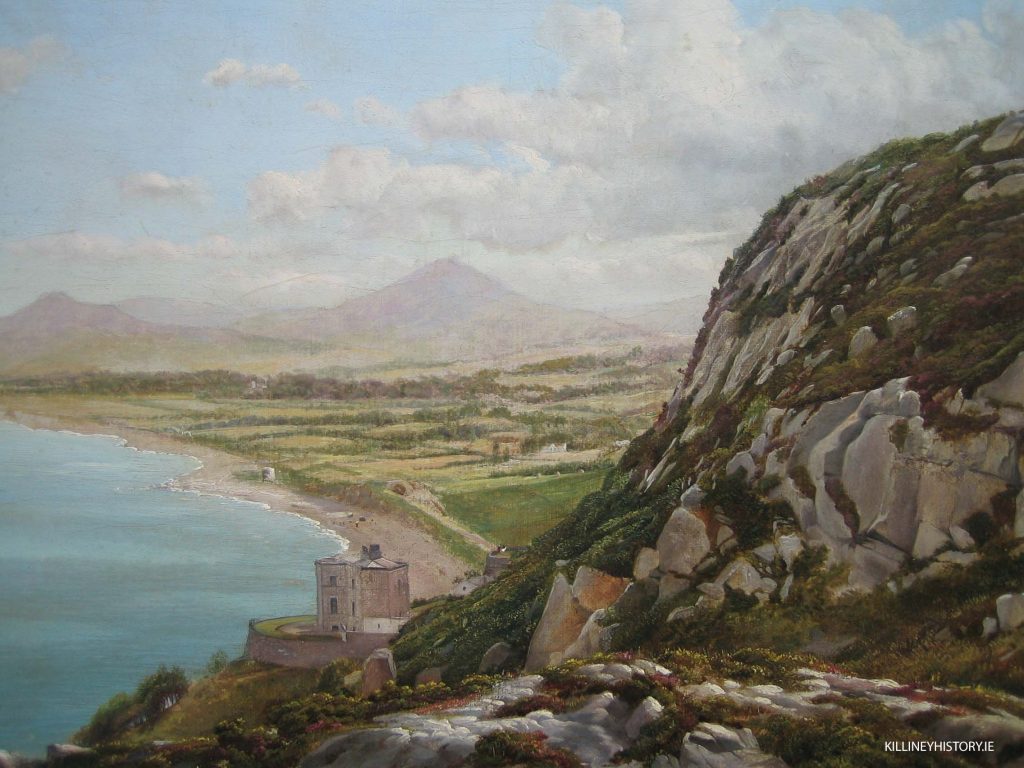
Gallery
Henry Eoghan O’Brien and family connection 1895-1969
We reproduce here an extract from Henry Eoghan O’Brien: An Engineer of Nobility by Gerald M. Beesley, 2018 which traces the O’Brien family connection with Mount Eagle.
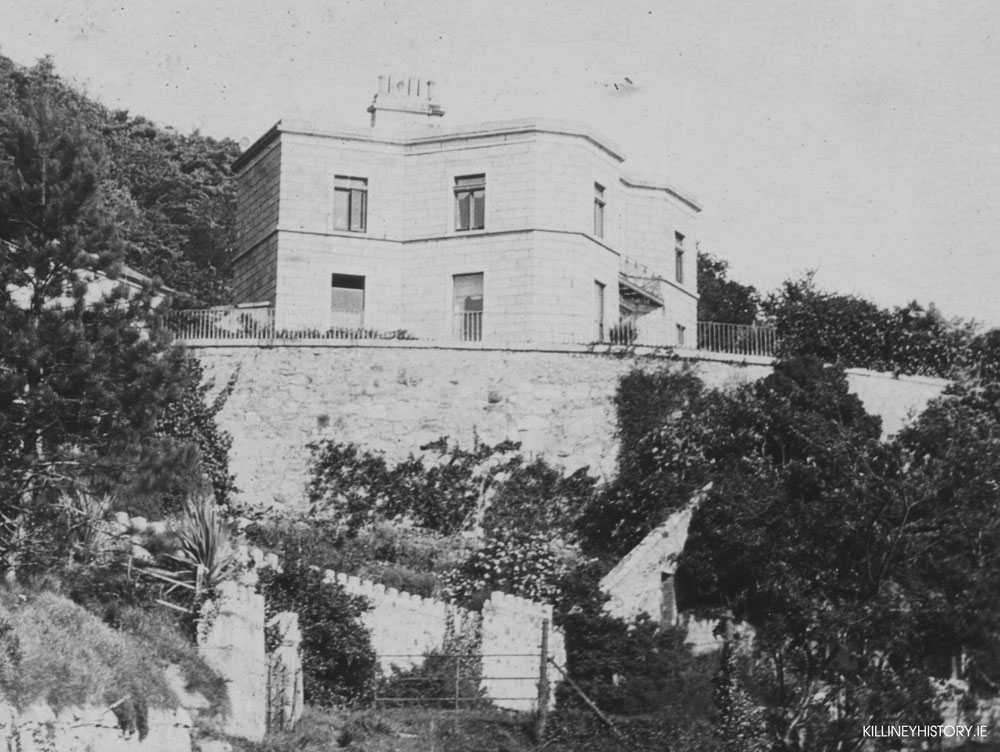
Mount Eagle, a Killiney property in a remarkable location with unparalleled views overlooking the sea, had, when completed in 1837, originally been named Coburg Lodge in recognition of the Saxe-Coburg family name of the new monarch, Queen Victoria. For a time it was later also known as Kent Lodge before assuming its better-known name. It was designed by Sandham Symes and constructed completely in squared and jointed blocks of ashlar granite stone, the symmetrical ‘Y-plan’ being a unique feature of the house. The design in the neo-classical style, has an attractive double staircase, and is decorated inside with plasterwork in the Greek Revival style. The six-acre site features a broad terrace that looks out over the Irish Sea, and the stables, which back onto the road, have cut stone details. Sandham Symes was a nephew of Robert Warren and was commissioned by him to design many new buildings around Killiney Hill. A fine wooden model of Mount Eagle, which used to be displayed in the house, bore Symes’ signature.
Among other buildings in Killiney designed by Symes was Holy Trinity (Church of Ireland) church. Robert Warren gave the site for this church and also made a substantial donation towards the cost of its construction. It was completed in 1858, and the first incumbent was Revd Joseph Samuel Bell (1831-91) who served the parish until 1867.
Mount Eagle was vacant for some years prior to 1873, when Sir Ralph Smith Cusack, Chairman of the Midland Great Western Railway, occupied it. He moved to Furry Park, Raheny, in 1875, and by 1878 Graves Chamney Colles was in residence at Mount Eagle, and lived there until his death in November 1892. Murrough O’Brien, father of Henry Eoghan O’Brien, acquired the property from Mrs Colles in June 1895 for £3,500, including furniture, but he continued to reside at Mount Mapas and let Mount Eagle to Wilfrid Fitzgerald until September. It was then taken for a very short period by John Morley, the Chief Secretary for Ireland (1892-95) who had just lost his seat at the 1895 election. Murrough and Ellen moved into Mount Eagle on 10th October 1895 having vacated Mount Mapas.
The formative years
For the young Henry Eoghan O’Brien early life at Mount Mapas and Mount Eagle, overlooking the DW&WR line between Killiney and Dalkey, would have provided him with ample opportunity to observe railway activities. It is not known whether or not the sight, sound and smells of steam locomotives got ‘into his blood’ at an early age, but living in such close proximity to the railway must have had some influence on the young boy.
During his studies Eoghan still managed to get home to Killiney for Christmas and Easter, and it was at Easter 1899 that he first met the Smythe family. They had recently moved into Court-na-farraga and their arrival brought to the neighbourhood a bright 14-year old girl; Frances Victoria Lucy Smythe, who had been born at Lauragh on 3rd March 1885, and who would later catch the eye of her young neighbour from Mount Eagle Henry Eoghan O’Brien. They married on 10th January 1905 and you can read Gerald Beesley’s description of the event here.
Garden parties in the 1930’s
Among the fashionable events in the Dublin social calendar during the 1930s were the garden parties that Frances O’Brien organised each year at Mount Eagle in order to raise funds for charity. These occasions were always well attended, up to as many as 200 guests being known to visit Mount Eagle in an afternoon to view her beautifully tended garden with its great variety of flowers and to gaze upon the vista of Killiney Bay; tea being served in the house. On the personal front, a happy family event occurred in 1935 when it was announced that Lt. Brian Eoghan O’Brien RN and Elizabeth, only daughter of Dr & Mrs S.S. Strahan of Hong Kong, had become engaged; they were married in Hong Kong on 10th February 1936. The happy couple managed to get to Ireland in April in time for the 1936 garden party at Mount Eagle, at which event they were presented to friends and relatives.
Final days in Killiney
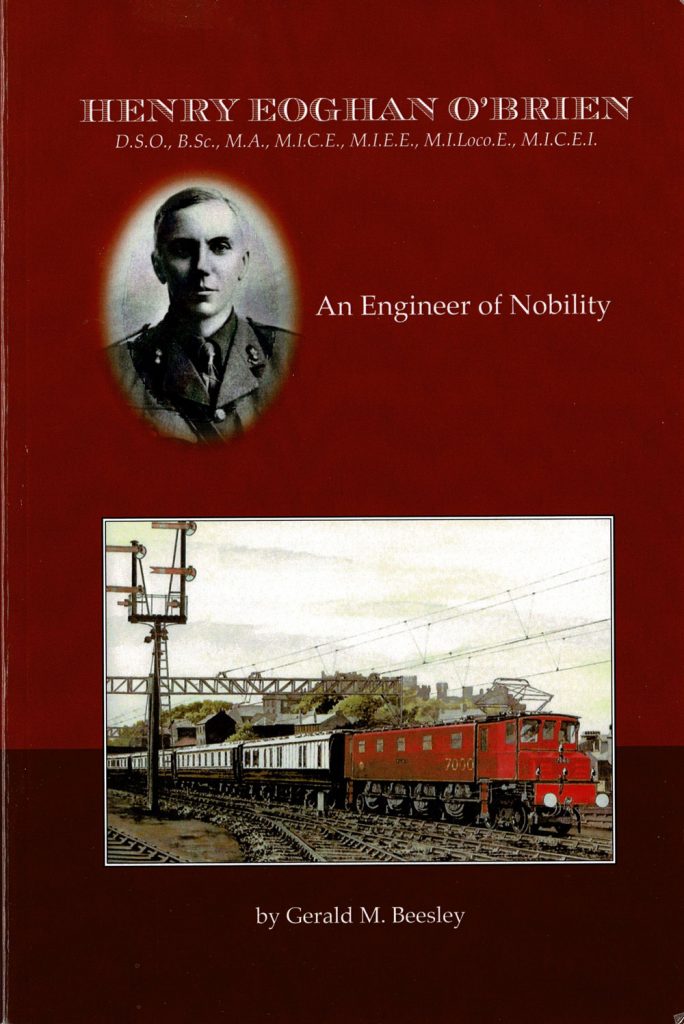
Bed ridden with arthritis in his last days, H.E. O’Brien still always welcomed visitors to Mount Eagle, especially if they came to talk about railways. It seems fitting that one of the 20th century’s more important railway engineers, who had been born within earshot of trains running along the coastal line between Dublin and Bray, should pass from this life also in close proximity to that same railway line, but to the sound of diesel, rather than steam trains. Henry Eoghan O’Brien died on 9th September 1967 at Mount Eagle, Killiney in his 92nd year. His remains were cremated at Liverpool Crematorium at 12:40 on Thursday 15th September 1967. Frances Victoria Lucy O’Brien survived her husband by a further seventeen months. She died at a Dublin nursing home on 15th February 1969 and she was buried at Deansgrange cemetery on 18th February 1969. Following their deaths Mount Eagle was put up for sale and Dun Laoghaire Corporation tried to buy the property in order to extend the public park at the Vico Road, but were outbid at auction by Con Smith, a private buyer.
Description by Peter Pearson (1998)
Mount Eagle was designed by Sandham Symes and built in 1837. Sandham Symes was a nephew of Robert Warren and was commissioned by him to design many new buildings around Killiney Hill. A fine wooden model of the house, which has always remained on display at Mount Eagle, bears Symes’s signature and illustrates the unusual Y plan of the house. Like Ayesha, it is built completely in granite ashlar, in squared and jointed blocks of stone, and it also has a broad terrace which looks out over the Irish Sea. Unlike Ayesha, it is designed in the neo-classical style and is decorated inside with plasterwork in the Greek Revival manner. It also has an attractive double staircase and is completely symmetrical in plan. The stables of Mount Eagle, which are also very well built and have cut-stone details, back onto the road.
Records from Thom’s Directory
RESIDENTS of MOUNT EAGLE
1850 Robert Warren
1860 No Reference
1870 Vacant
1880 George C. Colles
1887 Graves C. Colles
1888 Graves C. Colles
1889 Graves C. Colles
1890 Graves C. Colles
1892 Graves C. Colles
1900 Murrough O’Brien
1910 Murrough O’Brien
1912 Murrough O’Brien
1920 Colonel E. O’Brien
1928 Colonel E. O’Brien
1930 Colonel E. O’Brien
1940 Colonel E. O’Brien
1950 Colonel E. O’Brien
1954 Kathleen Lloyd, Mount Eagle Lodge
1960 Colonel E. O’Brien
1960 Costa Hemple, Mount Eagle Lodge
